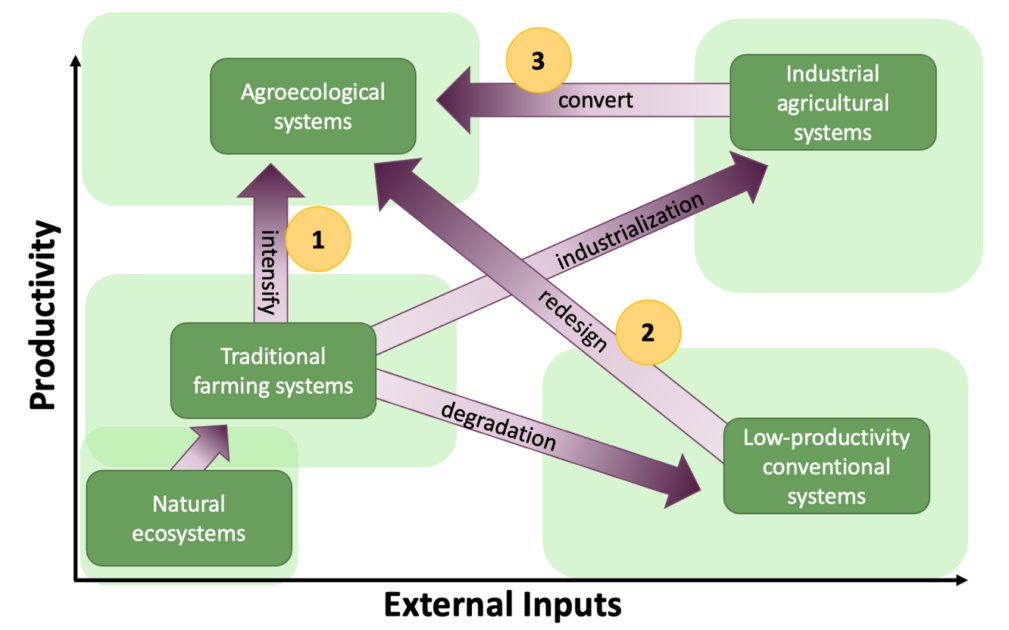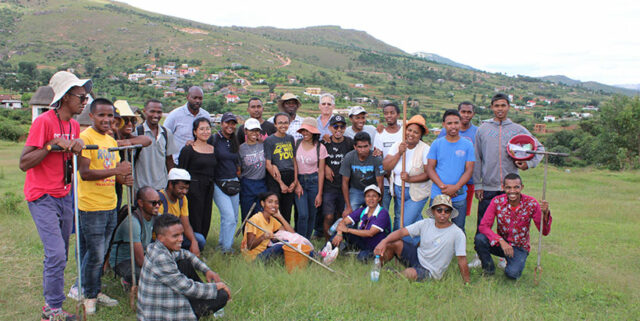
Authors of this blog post: Cargele Masso (IITA), Christine Lamanna (CIFOR-ICRAF), Matthias Geck (CIFOR-ICRAF) and Sarah Jones (Alliance Bioversity-CIAT)
Download the context documents:
Increasingly in the spotlight, agroecology represents a holistic approach to agriculture that not only takes into account the ecological and social aspects of farming systems, but actively enhances their viability. It does so by “optimizing the interactions between plants, animals, humans, and the environment while taking into consideration the social aspects that need to be addressed for sustainable and fair food systems” (FAO, 2018). Being based on a consolidated set of 13 principles, agroecology can directly support the sustainable transformation of food systems (Figure 1).

Figure 1: The five levels of agroecological transitions, adapted from Gliessman levels (in Wezel et. al., 2020) in relation to the 13 principles of Agroecology (HLPE, 2019).
It goes without saying that the way these principles are applied in a food system strongly depends on the specific characteristics of the local contexts. To reflect the existence of different starting points for agroecological transitions, the CGIAR Agroecology Initiative recognizes three general transition pathways towards agroecological food and farming systems, which are:
- Agroecological intensification of low-productivity and low-input systems to improve livelihoods and productivity;
- Re-design of agricultural systems with low profitability and high external inputs;
- Conversion of agricultural systems that are profitable but rely on high external inputs (Figure 2).
The choice of the pathway must take into account the local context in alignment with one of the key principles of agroecology – the co-creation of knowledge.

The Initiative aims to support agroecological transitions in the Global South through co-design of agroecological innovations, value chains, and policies. It is generating evidence through the application of novel assessment frameworks of economic, environmental, and social performance of food systems at different stages of the agroecological transition. The Initiative’s activities are centered around Agroecological Living Landscapes (ALLs) in eight countries – namely Burkina Faso, India, Kenya, Lao PDR, Peru, Senegal, Tunisia, and Zimbabwe (Figure 3). The ALLs were selected to include:
- Diversity of environmental, economic, and social contexts;
- Evidence of ongoing activities that boost the agroecological transitions on the ground and create opportunities for complementarity and synergy;
- Networks of food system actors interested in agroecology to engage with; and
- Preliminary feedback from key stakeholders on research priorities and needs that should be addressed to facilitate the agroecological transition.

Figure 3: The Agroecology Initiative assessed the context for agroecology in diverse Agroecological Living Landscapes in Asia, Africa, and Latin America.
The context assessment in each of the ALLs therefore aimed at: (a) determining the environmental, economic, and social context of the agricultural and food systems, (b) compiling data and information available as evidence of the context, and (c) determining to which extent the 13 agroecological principles are currently applied. The information compiled will serve as a baseline for the Initiative and inform the development of targeted interventions.
The assessments mainly involved reviewing available information, using both peer-reviewed and grey literature as well as stakeholder consultations conducted in the project inception phase. In selected ALLs, key-informant interviews and focus group discussions were conducted to supplement available information. Following cross-country guidelines (Masso et al. 2022), the assessment has been completed in the eight countries.
Highlights from the context assessments already undertaken
India
Agriculture in Ananthpur district of Andhra Pradesh is dominated by smallholder farmers growing groundnuts, paddy rice and other crops, and is mainly limited by low or erratic rainfall and soil degradation. Thanks to the work of the Andhra Pradesh Community-managed Natural Farming (APCNF) Initiative, the 13 agroecology principles are already being commonly applied by local food system actors. The Initiative is therefore focusing on scaling up the ongoing activities and help redesign farming systems with the following objectives: reducing reliance on external inputs, improving water and soil management, and empowering farmers.
Kenya
The Murang’a-Kiambu-Machakos-Makueni corridor ranges from high-productivity farms that heavily rely on external inputs in the well-irrigated highlands to the dry lowlands, where livestock and fruit trees predominate. In the highlands, the environmental and human health impacts of excessive use of agrochemicals are a key concern, whereas in the lowlands, water scarcity and lack of opportunities to locally add value to raw products are some of the key limiting factors for building sustainable rural livelihoods. The Initiative is focusing on co-designing innovations to overcome these challenges, working closely with two ALL host centers – CSHEP in Kiambu and DNRC in Makueni, both of which already apply most of the agroecological principles in all their activities. The initiative is also collaborating with the National Government, through the multi-stakeholder platform ISFAA, in developing a national strategy for agroecology, to scale up these pioneering approaches.
Peru
The Ucayali district has been declared an “Agroecology Corridor” by the Peruvian Government, stretching from the eastern slopes of the Andes to the Amazon basin. As a main economic activity in the district, cacao production is also one of the key drivers of deforestation and biodiversity loss. External input use is low among cacao growers, and few make use of organic inputs even when, potentially, they could easily exploit livestock or annual crops for nutrient recycling. Farmer cooperatives are key social and economic structures in supporting knowledge sharing and capacity building as well as advocating for farmer participation and fairness in value chains – particularly for exported commodities like cacao. The Initiative will hence center its activities on organic cacao growers’ cooperatives, to help co-design agroecological innovations to improve cacao production without negative environmental and social impacts.
Senegal
In the Department of Fatick where the ALL is situated, rainfed Sahelian agriculture is generally diversified, with trees playing a major role and livestock present on almost every farm. Compost and manure are commonly used as organic fertilizer. Most farmers grow millet and groundnut in crop rotations as a means to manage soil fertility and control pests. However, family agriculture is vulnerable to variable rainy seasons and also faces limited access to agricultural inputs. Through the national association called Dynamique pour la Transition Agroécologique au Sénégal (DyTAES), which promotes agroecology mainly through policy advocacy, the ALL in Fatick will work to accelerate the agroecology transition through the co-construction of mixed crop-livestock systems, new business models to improve inclusion of small-scale farmers and marketing of local products (millet and milk) within the local food system, and inclusive participation to create a large agroecology coalition with adapted local public policies.
Tunisia
The Kef and Siliana governorates of northwest Tunisia are characterized by heavy erosion and soil degradation, exacerbated by monocropping of cereals and high grazing pressure from livestock. The Initiative is centering its activities around four Gender-mixed and women exclusive farmers’ organizations with differing degrees of applying agroecological principles. Some are quite advanced when it comes to connectivity and fairness, while others currently focus more on agroecological farming practices. Stakeholders in the Tunisia ALL envision three agroecological transitions pathways: (i) the integration of crop-livestock systems – from seed multiplication to value addition of animal products – and boosting their resiliency and autonomy (ii) the valorization and use of a diverse set of olive products and by-products in agroforestry systems, and (iii) the promotion of local agricultural products as paths of diversification, with a focus on honey and carobs.
Zimbabwe
In Mbire and Murehwa districts in northern and northeast Zimbabwe, cereals, legumes, livestock, vegetables and cotton are key to local livelihoods. In addition to a general marginalization of small-scale farmers, intensifying droughts and floods, as well as recurrent human-wildlife conflicts in Mbire, are seen as the key threats to sustainable agricultural production in the districts. Several projects in the two areas have emphasized selected agroecological principles and practices, yet none of them had a pronounced systemic perspective, resulting in limited integration of agroecology in the region. The Initiative thus aims to adopt such a systemic approach and co-develop and scale technological and institutional innovations, in order to support Mbire and Murehwa in their transition toward agroecology – with a particular focus on cereals, legumes, livestock, vegetables and cotton.
Context specificity of agroecology
The context assessments carried out by the Initiative highlight the remarkable diversity of agricultural and food systems in the ALLs. The economic, environmental, social, and political contexts are highly varied and do not justify simple, one-size-fits-all, approaches to render these systems more sustainable. Key to agroecological research is an option by context approach (Sinclair and Coe, 2019): the principles of agroecology and previous experiences can provide the options, yet contextualization is only possible by engaging thoroughly with local stakeholders and integrating their perspectives and priorities at every step of a research project.
In each of the assessed ALLs, pioneering actors have initiated agroecological transitions, reflective of the local biophysical and socio-cultural landscapes. Agroecology emphasizes the importance of transdisciplinary co-creation of knowledge and of building transition pathways that take into account existing strengths and capacities. The Initiative aims at doing research differently, thereby contributing to systems transformations that are well-contextualized and owned by local food system actors. The starting points for agroecological transitions are unique to each living landscape, highlighting the critical importance of co-creating transition pathways that are equally unique rather than promoting silver bullets ill-suited for highly diverse contexts.
References
- FAO. 2018. The ten elements of agroecology: Guiding the transition to sustainable food and agriculture systems. Rome: Food and Agriculture Organization of the United Nations. http://www.fao.org/3/i9037en/i9037en.pdf.
- Masso, Cargele; Lamanna, Christine; Kettle, Christopher; Wickramaratne, Chaturangi; Jones, Sarah; Dickens, Chris. 2022. Guidelines to the agroecology-I context document. Colombo, Sri Lanka: International Water Management Institute (IWMI). 13p. https://hdl.handle.net/10568/126393
- Wezel, A., Herren, B.G., Kerr, R.B. Barrios, E., Goncalves, A.L.R., and Sinclair, F. 2020. Agroecological principles and elements and their implications for transitioning to sustainable food systems. A review. Agronomy for Sustainable Development https://doi.org/10.1007/s13593-020-00646-z
- Sinclair, F. and Coe, R. 2019. The options by context approach: A paradigm shift in agronomy. Experimental Agriculture, 55(S1), 1-13. doi:10.1017/S0014479719000139



